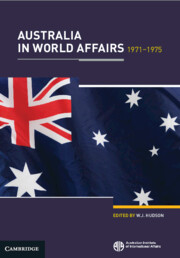535 results
3 - The Toronto Context
-
- Book:
- Heritage Languages
- Print publication:
- 27 June 2024, pp 29-36
-
- Chapter
- Export citation
Chapter 24 - Border Crises
- from Part IV - Anxious Neighbourhoods, Uncertain Futures
-
-
- Book:
- Europe in British Literature and Culture
- Print publication:
- 13 June 2024, pp 385-419
-
- Chapter
- Export citation
Chapter 20 - Culinary Longings
- from Part III - Cultural Transfers
-
-
- Book:
- Europe in British Literature and Culture
- Print publication:
- 13 June 2024, pp 322-336
-
- Chapter
- Export citation
Chapter 22 - Britain as the ‘Asylum of Nations’
- from Part IV - Anxious Neighbourhoods, Uncertain Futures
-
-
- Book:
- Europe in British Literature and Culture
- Print publication:
- 13 June 2024, pp 354-368
-
- Chapter
- Export citation
4 - Queering Immigration and the Social Body, 1875–1924
- from The Sexuality of American History
-
-
- Book:
- The Cambridge History of Queer American Literature
- Published online:
- 17 May 2024
- Print publication:
- 06 June 2024, pp 89-109
-
- Chapter
- Export citation
Chapter 10 - Second-generation Afghan Immigrants Navigating Racial and Ethnic Identities in College
- from Part II - Experiences
-
-
- Book:
- Supporting College Students of Immigrant Origin
- Published online:
- 16 May 2024
- Print publication:
- 23 May 2024, pp 200-222
-
- Chapter
- Export citation
Chapter 4 - The Role of Family Histories in Students of Immigrant Origin’s Aspirations and College Decision-making Process
- from Part I - Beginnings
-
-
- Book:
- Supporting College Students of Immigrant Origin
- Published online:
- 16 May 2024
- Print publication:
- 23 May 2024, pp 64-86
-
- Chapter
- Export citation
Frustration and fidelity: how public interest lawyers navigate procedure in the direct representation of asylum seekers
-
- Journal:
- Law & Society Review / Volume 58 / Issue 2 / June 2024
- Published online by Cambridge University Press:
- 16 May 2024, pp. 270-293
- Print publication:
- June 2024
-
- Article
-
- You have access
- Open access
- HTML
- Export citation
3 - Gender, Migration, and Sexuality in the Modern World
-
-
- Book:
- The Cambridge World History of Sexualities
- Published online:
- 26 April 2024
- Print publication:
- 16 May 2024, pp 50-70
-
- Chapter
- Export citation
Categorical Inequalities and Canadian Attitudes toward Positive and Negative Rights
-
- Journal:
- Canadian Journal of Political Science/Revue canadienne de science politique , First View
- Published online by Cambridge University Press:
- 13 May 2024, pp. 1-23
-
- Article
-
- You have access
- Open access
- HTML
- Export citation
Branching processes in nearly degenerate varying environment
- Part of
-
- Journal:
- Journal of Applied Probability , First View
- Published online by Cambridge University Press:
- 10 May 2024, pp. 1-20
-
- Article
- Export citation
“We Are Happy Here”: Creating Communist Cuba and the Mariel Crisis of 1980
-
- Journal:
- Latin American Research Review ,
- Published online by Cambridge University Press:
- 07 May 2024, pp. 1-23
-
- Article
-
- You have access
- Open access
- HTML
- Export citation
8 - Australia and Europe
- from Part II - Relationships
-
-
- Book:
- Australia in World Affairs 1996–2000
- Published online:
- 04 May 2024, pp 91-103
-
- Chapter
- Export citation
5 - Immigrant Organizing and Activism
- from Part I - Organizing and Activism
-
-
- Book:
- The Cambridge Handbook of Community Empowerment
- Published online:
- 18 April 2024
- Print publication:
- 25 April 2024, pp 139-161
-
- Chapter
- Export citation
4 - Luton
-
- Book:
- Politics of the Past
- Published online:
- 05 April 2024
- Print publication:
- 11 April 2024, pp 136-165
-
- Chapter
- Export citation
6 - Birmingham
-
- Book:
- Politics of the Past
- Published online:
- 05 April 2024
- Print publication:
- 11 April 2024, pp 201-236
-
- Chapter
- Export citation
‘Entirely white’? Female immigrants and domestic work in Italy (1960s–1970s)
-
- Journal:
- Modern Italy / Volume 29 / Issue 2 / May 2024
- Published online by Cambridge University Press:
- 02 April 2024, pp. 166-181
- Print publication:
- May 2024
-
- Article
-
- You have access
- Open access
- HTML
- Export citation
4 - Immigration
-
-
- Book:
- Australia in World Affairs 1971–1975
- Published online:
- 29 March 2024, pp 93-110
-
- Chapter
- Export citation
7 - Immigration: 1949–1970
- from Part Two - The International Community
-
-
- Book:
- Australia in World Affairs 1966–1970
- Published online:
- 29 March 2024, pp 171-205
-
- Chapter
- Export citation

Australia in World Affairs 1971–1975
-
- Published online:
- 29 March 2024







